A spectacular vase made of plasticine - a fun way to express your creative side and add coziness and originality to the interior. Its production is quite manageable not only for a beginner, but also for an experienced creator. The resulting product will please the master for many years. And the best part is that to make such a vase you need only the simplest and most accessible materials.
Necessary materials and tools
Such a vase can be called a budget option for a gift or interior decoration. Its production does not require rare expensive materials. Often, the craftsman has previously used plasticine (left over from children's crafts) in stock.
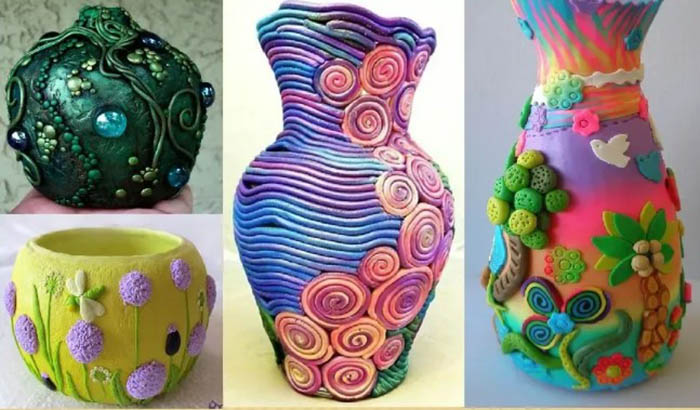
If desired, it can also be used to make spectacular home decor. Even a mixture of different pieces of plasticine in the form of a vase will look interesting and original. In general, it will become the main material for the craft under discussion.
You can choose plasticine of one color, but the product made of material of different beautiful shades will look much more interesting. There can be from 2 to infinity. Everything depends on the taste and preferences of the master.
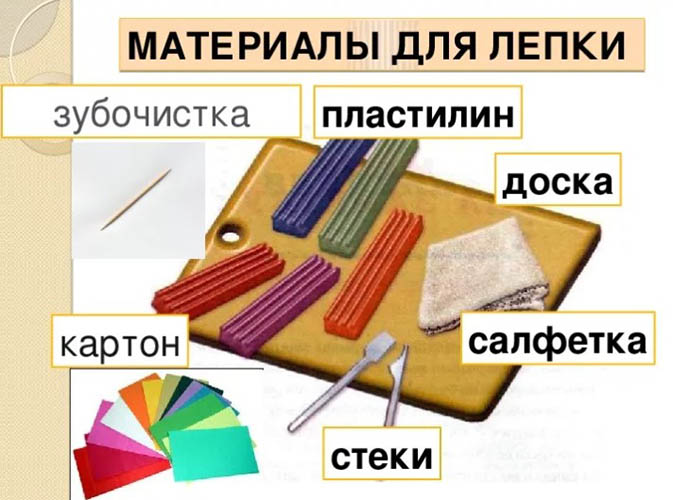
Today, you can find many varieties of soft plasticine on sale. But it is not suitable for making a vase. The product is very light, unstable, and quickly spoils. In order for such a vase to stand on a shelf, you have to make a weighted bottom for it, which significantly complicates and lengthens the entire process.
In addition to plasticine, you will need other materials and tools - their list is published in the table:
| Materials and tools | Peculiarities |
| Convenient flat work surface | To work with plasticine, it is worth using a suitable hard, dense surface. This will facilitate the process and protect the table from difficult stains. You can take a light wooden board or a sheet of plastic, oilcloth, or suitable fabric. |
| Sufficiently sharp scissors | They will be needed to separate pieces of plasticine of the appropriate size, and also to cut off the excess. |
| Various modeling tools | These are, for example, cutters, blades. They facilitate the creation of various shapes and textures. |
| Varnish or other suitable clear coat | They are taken to fix and preserve the finished work. Such coatings protect the vase from rapid deterioration, various damages |
| Additional decorations | To decorate the product, you can take beads, rhinestones, stones, any beautiful additional elements. Even miniature figurines, toys, parts from old jewelry will do |
Before you start working, you should make sure that all the necessary materials and tools are prepared.
Classic model of a vase made of plasticine
A plasticine vase made using the classic scheme is quick and easy to create. The instructions published below will be understandable even for a novice craftsman.
The first thing you need to do is prepare for the process. It is important to cover the table with a plastic sheet or other covering, and also make sure that the surface is perfectly clean and smooth. It is advisable to immediately start preparing the plasticine. It is divided into identical pieces by color for ease of work.

Sometimes the master immediately decides to mix shades of plasticine to get a product with an original unique design. Usually contrasting colors are combined so that the difference between them is immediately visible.
Next you need to:
- Work on the base of the vase. To do this, take one piece of plasticine and transform it into a cone or cylinder with your hands. This will be the basis of the product.
- Continue working with plasticine. If you choose a quality material, it will be easy and comfortable to work with it. You will be able to knead the plasticine with your fingers and model it. You need to work with it until you achieve the desired shape and size of the future product.
- Create the neck of the vase. At this stage, you will need scissors. They cut off the upper part of the resulting base. You can make this part of any shape and size to your taste.
- Form the neck. For this, take an additional portion of plasticine. Material of the same color or contrasting to the base will do.
- Decorate the vase. Here it is better to use plasticine of other colors so that the decorations are clearly visible on the base. You can make decor from additional elements. For example, use plastic flowers, beads, locks. It all depends on the chosen style of the vase. Or you can mold buds, leaves, any patterns from plasticine yourself and carefully attach them to the surface of the product. In order for the vase to turn out beautiful and original in the end, do not be afraid to experiment with different shapes and textures.
- Evaluate the result. At the very end, you need to carefully examine the vase from all sides and make sure that the master is completely satisfied with the result of the work. If not, then at this stage you will still be able to correct some points.
When the work is finished, you first need to leave the vase on the table to dry. How long it will take depends on the material. The optimal drying time will be indicated on the plasticine package.
Then you can use a vase or fix the result with varnish or another transparent coating. This will preserve and protect the product from external influences for a long time.
You can easily put live or artificial flowers in a ready-made vase. You can also simply use it as a decoration.
Multicolored vase
A plasticine vase can be not only monochromatic, but also bright and colorful. To do this, you will need to stock up on material of different colors in large quantities. It is convenient to immediately divide it into pieces of the same size.
The easiest way to start working is with one color. You need to choose the one that will be the main one in the vase. For example, brown, black, green. There are no strict restrictions on this issue.
In the process it is necessary:
- Take a piece of plasticine of the main color that is suitable in size and form a cylinder or cone out of it. This will be the base of the product. In the process, you will need to work with the material with your fingers, softening and modeling it to the desired shape.
- Add color layers. When the base is ready, you can take additional pieces of other colors. Each must be divided into small pieces before use. They cover the base of the product from different sides. In this way, new colored layers are applied one after another.
- Connect all parts. The most convenient way to use special modeling tools for plasticine is in the process. But you can also use your fingers. The main thing is to try to create the smoothest and most imperceptible transitions between different colors. There can be any number of them.
- Form the neck of the product. The top of the structure is cut off with a knife or scissors. The neck of the desired height and shape is molded by hand.
- Decorate the vase. You can decorate the product in a variety of ways. For example, using children's molds, cut out characters from plasticine rolled out with a rolling pin and attach them on top. Or roll thin strips of material into flagella and add to the product. The main thing is to securely attach the decorations.
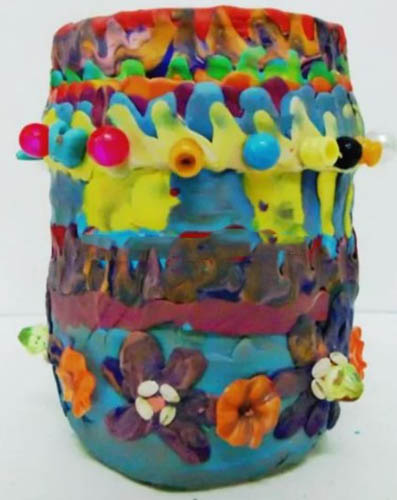
Only when the plasticine is completely dry, you can move on to covering it with varnish or another suitable agent. The drying period is usually from 1 to 5 days. This depends not only on the characteristics of the plasticine itself, but also on the thickness of the layer of the finished product.
Usually the vases are quite voluminous. If its walls are up to 1 cm thick, then it will take about 3 days to dry. If up to 5 cm, then the product will dry for about 5 days.
Original vase
A vase made of plasticine can be not only of a standard round shape, but also unusual and original. How to make one, we will consider further.
Necessary:
- Select plasticine of the desired colors. In order for the vase to turn out truly original, you should not limit yourself to one color. You can take several at once. For example, it is optimal to use 2-3 at once. Contrasting combinations look interesting: black, white and red, gray, pink and yellow, blue, crimson and white.
- Form a vase of an unusual shape from the main color material. It can be not only a usual cone, but also a cube or an imitation of an old jug. Today, rectangular vases are popular. Small branches of dried flowers or dry leaves are placed in them. This option is quite easy to mold, because you don’t even need to make a neck.
- Decorate the finished base. If you plan to use the resulting vase to decorate your home, you should consider the interior style. The decor for the product is selected according to it. It can be made of the same plasticine or from additional accessories. For example, from shells, fabric braids or flagella, various beads, rhinestones.
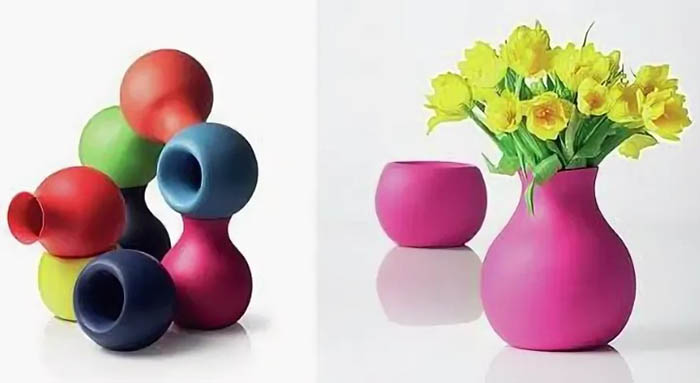
Additional pieces of plasticine can be used to make interesting details. This could be one handle or two on both sides, decorative figures, an elegant bottom or neck. Any such details will highlight the uniqueness of the master's work.
It is important to securely fasten the parts of the vase. For this, you can use both small pieces of plasticine and special modeling tools. All elements must hold well.
After the final drying, the product is covered with varnish again. You can choose another fixing composition for it. Some craftsmen decide to cover the plasticine with paint, but this is not the best solution. On such a basis, the coating will quickly begin to crack. In general, it will not cope well with its main task.
From plasticine sausages
A plasticine vase can be made in different ways. One of the most interesting among them is the use of sausages from the base material. For this option, it is not necessary to take even pieces of the base. Even plasticine mixed from different colors will do.
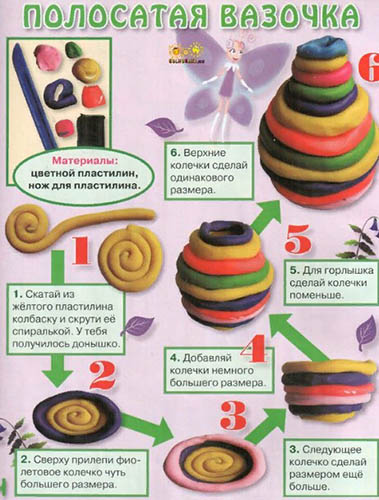
The material will be rolled into long sausages, so even its leftovers can be used for the process. A very budget-friendly and economical way of creativity.
In the process you need to:
- Choose one color of plasticine and pull out a piece, forming a long, neat sausage out of it. It is these details that will eventually become the basis of the vase.
- Next, you can roll each sausage into a circle., so that blanks of different sizes are obtained - from very small to impressive. The easiest way is to attach the finished parts to a plastic bottle, which will become the base of the vase. This will make the master's work much easier. Or simply attach the spirals to each other, creating the shape of the vase. But this is an unreliable method. The finished product can easily break.
- The second option is not to roll the resulting sausages into spirals, but simply place them on top of each other. in the form of a glass. The main thing is to make a stable, dense bottom in advance. Such a vase must necessarily widen upwards. You can also make your work easier and put a cardboard base inside the structure.
It is important to securely fasten all the parts together. It is convenient to use special modeling tools for this.
You can even just twist the plasticine sausages in a circle, creating a vase that resembles a wide basket in shape. The blanks for this option should be thick enough and fit tightly.
Another interesting way is to weave the same sausages using the basket principle, creating a strong fastening. The result is a beautiful and original weave.
Lastly, you can make the neck of the vase. To do this, take a small piece of plasticine of any color and form a thin sausage from it. It is twisted around the top of the product. You can create several layers at once, choosing the optimal height.
It is convenient to attach various decorations to the top of the sausages. These can be flowers, leaves, animal outlines, patterns. At the last stage, you will be able to fully reveal your creative imagination and create unique decorations.
What can I decorate with?
A plasticine vase can be decorated in dozens of different ways.
The following are used for this process:
- thin plasticine flagella (they are placed on top of the finished base);
- beads, rhinestones, processed pieces of glass;
- buttons;
- artificial stones;
- shells;
- lightning;
- nuts, seeds, cones;
- fresh and dried flowers;
- threads of different colors and thicknesses;
- shimmering sand.
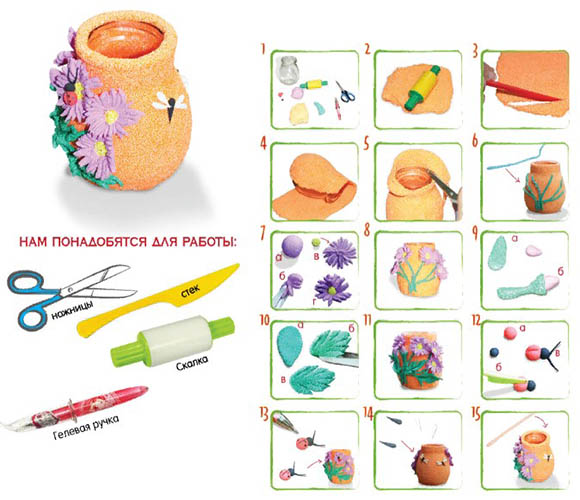
The easiest way to decorate a vase is to use acrylic paints. They can be used to paint the product or draw interesting patterns, images. But you should not use paints as a fixing material for parts. You should also apply a transparent varnish on top of them. It will simultaneously protect the surface and give it shine.
Rhinestones, stones, sequins, beads can make a vase more spectacular, elegant, eye-catching. They add shine and brightness to it. It is most convenient to attach such additions to a vase using glue.
Various hard elements (like buttons, shells with sharp edges) can be simply pressed into the product. They can hold up well even without glue or other additions.
In addition to shells, you can use other natural materials to decorate the vase. For example, pine needles, dried flowers, dried leaves, stones. They are simply inserted into the vase. Or you can glue the parts to the bottom and/or neck. Such a finished product fits perfectly into an eco-style interior, but will also suit various others.
An interesting decoration option is to experiment with different textures. Using improvised tools, you can create relief and original patterns on the surface of the product. For example, with a fork, toothpicks, different fabrics.
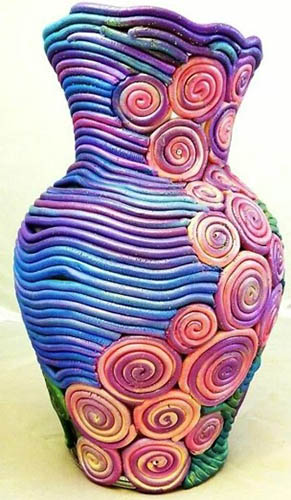
The tools can even create full-fledged drawings on the surface. These can be any thematic images, patterns, ornaments. Another option is to roll out a small layer of plasticine after creating the vase and cut out the necessary figures of different colors from it.
Afterwards, they will be attached to the surface with glue to create a bright, unique design. To make such figures, you can even use cardboard templates, cutting out the desired compositions.
Even a novice craftsman can make a vase from plasticine with his own hands. In the process, he can show his creative nature, experiment with various ideas and materials. You need to allow yourself to bring to life all the brightest fantasies and then in the end you will be able to create a unique vase that can become a real decoration of the house.
Video about modeling a vase from plasticine
